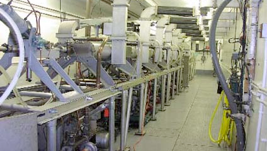
Rensselaer launched its plan for NE research in the late 1950s when the Atomic Energy Commission funded a project to construct a linear electron accelerator in 1958. The NE Department was officially formed in 1960 and is one of the oldest such programs in the U.S. The construction of the accelerator facility was completed in 1961 and the facility would soon be named after Professor Gaerttner who was instrumental in establishing NE at Rensselaer and who served as NE’s first departmental head. Within a few years, the NE Department at Rensselaer awarded its first PhD degrees and then B.S. degrees With rapid expansion of the educational program, the two-story Nuclear Engineering and Science Building was built in 1963 adjacent to the Gaerttner Linear Accelerator (LINAC) Facility. In the same year, Rensselaer decided to take ownership of the Walthousen Reactor Critical Facility (RCF), located in Schenectady, New York. (Detailed information about these two facilities are provided under Section 3.) In 1975, Professor Richard Lahey was recruited to be the department head from General Electric Company a manufacturer of the first-generation Boiling Water Reactors (BWR). Professor Lahey was elected a member of the National Academy of Engineering in 1994 and served as Rensselaer’s Dean of Engineering in the mid-1990s. Up to the 1980s, a number of faculty members also joined the NE Department, including Professors Bimal Malaviya, Robert Hockenbury, Marty Becker, Robert Block, John Corelli, Donald Harris, Owen Jones, Don Steiner, Robert Ryan, and Michael Podowski, culminating a highly visible and highly ranked (top-5) NE program.

In the 1970s and 1980s, Rensselaer’s NE program enjoyed an excellent reputation as an applied nuclear engineering department with high-quality students and distinguished faculty who were and still are supported by two major, internationally known nuclear research laboratories, the LINAC and the RCF. In the early 1990s, however, the NE program faced severe challenges as many other universities when the nuclear power industry entered its darkest period in the history after the Three Mile Island accident.
Nationwide, some NE programs were eliminated and campus-based reactors were decommissioned. Undergraduate class enrollment in Rensselaer’s NE Department dropped to below 10, and federal funding for NE related research became very scarce, allocated mostly to National Labs. Professor Michael Podowski, who became the NE Department Head in 1994, initiated a collaborative B.S. program with the U.S. Navy, targeting 600 enlisted personnel who were stationed at the Kesselring Site in Saratoga County and who were interested in pursuing a B.S. degree to advance their careers. For nearly a decade, until the Rensselaer Program for Graduates of Navy Nuclear Power School Navy was cancelled in 2008, Rensselaer’s NE program graduated a large number (about 200) of undergraduate NE students (with the largest graduating classes in the nation in 2005-2006).

To further mitigate the danger of single-digit undergraduate enrollments and limited research funding opportunities, Rensselaer decided to combine the NE program with other programs. In 1996, the NE program was merged with the Environmental Engineering Program and Professor Don Steiner became the Department Head for the newly formed Department of Energy and Environmental Engineering, which mirrored the emphasis on nuclear waste management by the U.S. DOE at that time.
Merely six years later, the NE program was once again merged to form the Department of Mechanical, Aerospace, and Nuclear Engineering (MANE), this time playing a minor role in the department, with Professor Steiner serving as the program director. During the late 1990s and early 2000s, there was a hiring freeze at Rensselaer and only 2 of approximately 6 program faculty vacancies were re-filled Professor George Xu was hired in 1994 to fill a federally mandated position held previously by Professor Robert Ryan as the Director, Office of Nuclear and Radiation Safety / Institute Radiation Safety Officer and Professor Yaron Danon was hired in 2000 in anticipation of the retirement of Professor Block, then the Director of the LINAC. Professor Steiner retired in 2006.